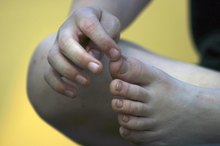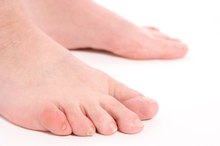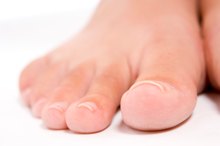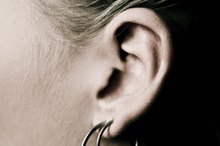How to Treat a Toenail Injury
If you have recently gotten your toenail smashed or partially torn off you may be wondering about the best course of treatment for your injury. There are different ideas on how to do this, but I would like to share with you my advice from recent personal experience.
If you are experiencing serious medical symptoms, seek emergency treatment immediately.
My big toenail was smashed under a hatch in the deck of a boat, and the bottom of the toenail was ripped up from underneath the skin. The bottom was completely detached, while the top sides hung on. Here is how I successfully treated my toenail injury.
Immediately after your toenail injury you should stop any bleeding by wrapping the toe in gauze, applying pressure, and elevating your foot. Your feet may bleed a lot because of the large number of blood vessels in them, but make sure that stitches are not necessary for your injury.
How to Treat Bruised Toenails
Learn More
It is important to clean the injured toe with an antiseptic as soon as possible (I used an iodine solution for the entirety of my injury). Soak and rinse your toe, then apply antibiotic ointment. Keep the toe wrapped in sterile bandages and gauze initially.
Depending on the severity of your toe injury, you may want to consider seeing a doctor or specialist at this point. I had my toe x-rayed to ensure that it wasn't broken. If you choose to continue home treatment, be meticulous about keeping the toe clean by cleansing with iodine solution twice a day, applying antibiotic ointment, and keeping it wrapped to prevent the nail from snagging on something.
How to Protect a Toe With No Nail
Learn More
Take your bandage off to air out the toenail when you have downtime throughout the day, and are sure you will not be at risk for catching it on anything.
Keep an eye out for signs of toenail infection: swelling, excessive redness, or discharge. Bacteria can easily become trapped under the remaining nail, this is why it is vital to keep it clean. Also, if your toenail is not draining, you may need to have a hole poked in the nail to drain the blood that has built up underneath.
Consider having the remaining toenail removed. I chose not to do this, but it is an option that was recommended to me. I felt that my toenail was acting as a protective barrier to the tender tissue underneath, and I preferred to let my body take care of it naturally. For me, this worked out well. Do what feels right for you.
Your toenail will eventually fall off on its own if it is damaged beyond repair. I waited about a month and a half after the injury and my nail came off cleanly while unwrapping my bandage one day (this may also be because I had it immersed in saltwater at the beach for several hours. You might try soaking it in a saltwater solution at home).
Once the nail comes off, the tissue underneath will be somewhat soft, sensitive and downright disgusting looking. Again, I recommend continuing your cleansing routine and keeping the toe wrapped, especially for the first few days. Once the tissue begins to harden, you can leave off the bandage (unless you are vain like me, and can't stand looking at a nail-less toe!).
A new nail will begin growing. You need not do anything but sit back and let your body take over. Just keep an eye on the nail and make sure it is growing back properly and not ingrown. If this is the case, talk to a podiatrist. Good luck and may you grow a beautiful new toenail!
Tips
If possible, wear open-toed shoes that do not put pressure on the injured toenail See a doctor right away if there are signs of infection
Warnings
I am not a medical doctor, and am not responsible for any advice you do or do not follow. This is just my opinion on what worked for me.
Related Articles
References
Tips
- If possible, wear open-toed shoes that do not put pressure on the injured toenail
- See a doctor right away if there are signs of infection
Warnings
- I am not a medical doctor, and am not responsible for any advice you do or do not follow. This is just my opinion on what worked for me.
Writer Bio
This article was written by the CareerTrend team, copy edited and fact checked through a multi-point auditing system, in efforts to ensure our readers only receive the best information. To submit your questions or ideas, or to simply learn more about CareerTrend, contact us [here](http://careertrend.com/about-us).









